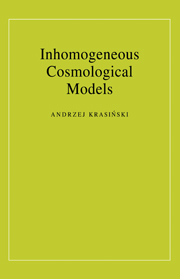Book contents
- Frontmatter
- Contents
- List of illustrations
- Preface
- Acknowledgements
- 1 Preliminaries
- 2 The Szekeres–Szafron family of solutions
- 3 Physics and cosmology in an inhomogeneous Universe
- 4 The Stephani–Barnes family of solutions
- 5 Solutions with null radiation
- 6 Solutions with a “stiff fluid”/scalar field source
- 7 Other solutions
- 8 Averaging out inhomogeneities of geometry and matter in cosmological models
- 9 Comments
- Appendix A Dictionary of abbreviations used in the text and in the diagrams
- Appendix B Why should one consider inhomogeneous models of the Universe?
- Appendix C Memorable statements about the cosmological principle
- Appendix D How was this review compiled?
- Appendix E Historical milestones
- Notes added in proof
- Bibliography
- Index
- Frontmatter
- Contents
- List of illustrations
- Preface
- Acknowledgements
- 1 Preliminaries
- 2 The Szekeres–Szafron family of solutions
- 3 Physics and cosmology in an inhomogeneous Universe
- 4 The Stephani–Barnes family of solutions
- 5 Solutions with null radiation
- 6 Solutions with a “stiff fluid”/scalar field source
- 7 Other solutions
- 8 Averaging out inhomogeneities of geometry and matter in cosmological models
- 9 Comments
- Appendix A Dictionary of abbreviations used in the text and in the diagrams
- Appendix B Why should one consider inhomogeneous models of the Universe?
- Appendix C Memorable statements about the cosmological principle
- Appendix D How was this review compiled?
- Appendix E Historical milestones
- Notes added in proof
- Bibliography
- Index
Summary
This work is a review of inhomogeneous cosmological exact solutions of the Einstein equations and their properties. A solution is, by definition, cosmological if it can reproduce any metric of the Friedmann (1922, 1924)–Lemaître (1927, 1931)– Robertson (1929, 1933)–Walker (1935) class (abbreviated FLRW) by taking limiting values of arbitrary constants or functions. The book is intended to attain two objectives: (i) to list all independently derived cosmological solutions and reveal all interconnections between them; (ii) to collect in one text all discussions of the physical properties of our Universe based on inhomogeneous models. Objective (i) is attained by showing that the more than 300 independently published solutions can be derived by limiting transitions from about 60 parent solutions. The solutions are arranged in relatively few disjoint families, and a few of them have been rediscovered up to 20 times. In attaining objective (ii) it is shown that exact inhomogeneous solutions can describe several features of the Universe in agreement with observations. Examples are the presence of voids and high-density membranes in the distribution of mass or the fluctuations of temperature of the microwave background radiation. Among the effects predicted are: (i) cosmological expansion of planetary orbits (unmeasureably small, but nonzero); (ii) prevention of the Big Bang singularity by an arbitrarily small charge anywhere in the Universe. In addition, papers that have discussed averaging the small-scale Einstein equations to obtain large-scale cosmological field equations have been reviewed.
- Type
- Chapter
- Information
- Inhomogeneous Cosmological Models , pp. xiii - xivPublisher: Cambridge University PressPrint publication year: 1997

